August 21, 2009
Air Date: August 21, 2009
FULL SHOW
SEGMENTS
There Will Be Flood
View the page for this story
Four years after Hurricane Katrina, New Orleans residents have read the official word on why the levees failed in the aftermath of the storm. It was a dense report from the Army Corps of Engineers, that was then evaluated by the National Academies of Science. Host Steve Curwood asks David Moreau from the National Academies of Science to help make sense of the government report – but it may not reassure New Orleans residents in flood-prone areas. (06:30)
Out of the Box Housing
/ Ingrid LobetView the page for this story
The increasing push to reuse materials has given some entrepreneurs a bright idea. Living on Earth’s Ingrid Lobet reports on how steel cargo shipping containers are becoming homes. (04:00)
Note on Emerging Science
/ Jessie MartinView the page for this story
New research shows that honey bees do even more to help flowers than we ever knew. Jessie Martin reports on honey bee bodyguards and their implications for sustainable farming. (01:40)
Harvesting Emissions
View the page for this story
The world's farmers bring us food, clothes, and increasingly - greenhouse gas emissions. Through crop and livestock production and land clearing, the world's agricultural sector is a bigger contributor to global warming than the transportation sector. Economist Sara Scherr, CEO of Ecoagriculture Parters, says it’s time to start looking at farmers as environmental stewards, not just food producers. She speaks with Steve Curwood about techniques that help farmers mitigate and adapt to climate change. (05:50)
Food Deserts
/ Jessica Ilyse KurnView the page for this story
Many low-income neighborhoods in the United States lack access to fresh and affordable fruits and vegetables. Residents in these so-called ‘food deserts’ rely on neighborhood corner stores and fast food chains as their main sources of food. But as Jessica Ilyse Smith reports from New York City, a number of programs are working to close the food gap by bringing healthy foods closer to home. (08:00)
The Language of Landscape
View the page for this story
Living on Earth continues its series exploring features of the American landscape, based on the book Home Ground: Language for an American Landscape, edited by Barry Lopez and Debra Gwartney. In this installment, Barry Lopez explains the term “soil.” (01:30)
Seedy Art
View the page for this story
At the Minnesota State Fair, seeds aren't just for planting – they’re used to create works of art. Living on Earth's Bobby Bascomb produced our audio postcard. (02:40)
In Search of Silence
View the page for this story
Gordon Hempton has traveled the world in search of undisturbed natural sound. But as the audio ecologist describes in his new book, “One Square Inch of Silence; One Man’s Search for Natural Silence in a Noisy World,” it’s getting harder and harder to find pure natural sound. Hempton has launched a campaign to raise awareness about noise pollution, and tells Steve Curwood why silence matters. (13:20)
The Art of Mud
/ Bethany Ericson’sView the page for this story
When commentator Bethany Ericson’s adult brother had some time on his hands, he decided to take up the Japanese craft of making perfect balls of mud. But his sister says the interest soon turned to obsession. (03:20)
This week's EarthEar selection
listen /
download
Sounds from a New Mexican ranch
Show Credits and Funders
Show Transcript
Host: Steve Curwood
Guests: Ivor van Heerden, David Moreau, Sara Scheer, Gordon Hempton
Reporters: Ingrid Lobet, Jessica Ilyse Smith, Bobby Bascomb, Bethany Ericson
Note: Jessie Martin
EarthEar: Bernie Krause
[THEME]
CURWOOD: From Public Radio International - this is Living on Earth.
[THEME]
CURWOOD: I’m Steve Curwood. Four years after Hurricane Katrina the debate continues about how best to prepare for another major storm in the gulf. Some say the present levee system promises more than it can truly deliver.
MOREAU: There are 350 miles of protective structures around New Orleans. It's a virtual impossibility to ensure that all 350 miles of that system are going to be fully functional a hundred percent of the time.
CURWOOD: Also – the hunt for healthy food in the inner city.
BARONBERG: People would say to me I really want to make these changes, I want to switch to 1% milk, I want to eat more fruits and vegetables, I want to be healthier but I can’t. My bodega only sells junk food and there aren’t any supermarkets. So what am I supposed to do?
CURWOOD: Eating in the city - and more - this week on Living on Earth! Stick around.
[THEME]
There Will Be Flood
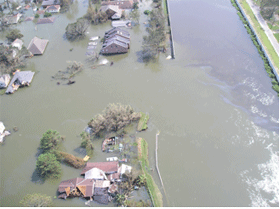
17th Street Canal Breach. (Photo: IPET)
CURWOOD: From the Jennifer and Ted Stanley Studios in Somerville, Massachusetts, this is an encore edition of Living on Earth. I’m Steve Curwood. On August 28th, 2005, Hurricane Katrina hit the south coast of the United States. The results have been devastating and long lasting.
Four years later, as this year’s hurricane season picks up, much of the Gulf region still faces dire threats from flooding should another storm strike. after Katrina, Ivor van Heerden, the deputy director of the Louisiana State University Hurricane Center was among those who urged authorities to rethink the levee system. He suggested that the size of the protected areas should be scaled back, but the levees should be made stronger where they protect core areas including downtown New Orleans.

Ivor Van Heerden
CURWOOD: How many people right now live outside the protected system you're talking about?
VAN HEERDEN: It probably amounts to maybe 100,000 at the most. The bottom line in all of this is as you plan is it has to be a case of not what's good for me, but what's good for the most folk, what's good for everybody, what makes the best sense for the overall population in coastal Louisiana.
CURWOOD: At the time, Ivor van Heerden’s ideas were viewed with a lot of skepticism.
But recently the National Academy of Sciences reviewed thousands of pages of recommendations and records compiled by a task force led by the U.S. Army Corps of engineers and came to conclusions surprisingly similar to those of van Heerden.
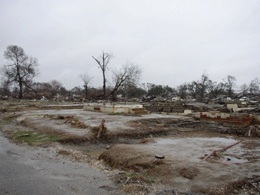
The Lower Ninth Ward in January 2006, about five months after Katrina. (Photo: David Moreau)
MOREAU: The report is remarkably candid in several places. Particularly candid in terms of its assessment of the failure along the 17th Street Canal which led to the flooding of a major portion of the central city. So there's nothing being papered over there. Whether it's this report or the general information about what happened during Katrina, there will be a very significant change in the design of protective facilities. There will be a substantial change in how the risk is communicated. The committee recommended that in fact the IPET staff actually hire a firm that is specializes in communicating with the public to take the findings and translate those into common, everyday language.
CURWOOD: People were told that the system was built to a 100-year flood, perhaps a 200-year flood protection, and yet there was this failure. What do we need to change about our thinking of risk assessment when it comes to flood protection?
MOREAU: The 100-year return period is an average return period. But there's a very substantial likelihood that that during a thirty-year mortgage that if you in fact knew exactly what the likelihood was it would be around 25, 27 percent.
CURWOOD: So, wait a second – if I were told that over the life of say owning a house it had a 27 percent chance of getting flooded out, that doesn't seem like acceptable odds.
MOREAU: It's not. For a place like New Orleans, it's totally unacceptable. The real message is if you live in areas that are below sea level – you're at risk. And you should exercise caution, should be prepared for failures if they occur.
CURWOOD: Now, some have suggested that the southern part of Louisiana is simply too difficult to protect, that some place south of New Orleans, but north of the far reaches of the state, permanent settlements just really should not be allowed. Based on what you see in this report, how practical is that suggestion?
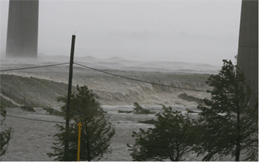
Overtopping along Gulf Intracoastal Waterways. (Photo by IPET)
CURWOOD: Well, at this point we know that the cost of the Katrina floods is at some place north of I believe $80 billion.
MOREAU: Right.
CURWOOD: For 80 billion bucks, do you think we could protect New Orleans?
MOREAU: For 80 billion bucks you could do a lot of other things that might be a lot more beneficial than rebuilding levees or making them higher. You might be able to relocate people. You might be able to create jobs in areas that are substantially at less risk. It requires some additional analysis that has not yet been publicly released.
CURWOOD: Professor David Moreau, thank you so much.
MOREAU: Thank you, Steve.
[MUSIC: John Scofield “That’s Enough” from Piety Street (Emarcy Records 2009)]
Related link:
For more on David Moreau, click here.
Out of the Box Housing
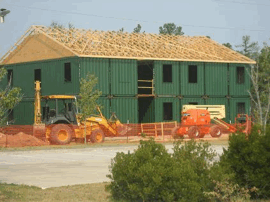
A hurricane-proof house under construction. (Courtesy of SG Blocks)
CURWOOD: Shipping containers are those big steel boxes you find at ports, railyards – and loaded on trucks. And usually they’re used just for that – shipping. But as Living on Earth’s Ingrid Lobet reports, some entrepreneurs are transforming containers into home sweet home.
[FORKLIFT BEEPS]
LOBET: Forklifts move exhibits into place at the EcoBuild America show in Orange County, CA. David Cross of SG Blocks stands at his exhibit, a steel box with one half converted into a living space.
CROSS: What we're looking at here is a forty-foot cargo container: eight feet wide, it's nine and a half feet tall and it's forty feet long.
[BANGING ON SIDE OF METAL CONTAINER]
LOBET: One side of the container has been removed, and window and door openings have been cut into the sides and ends.
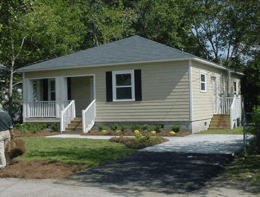
The right side of this home is an addition made of shipping containers.(Courtesy of SG Blocks)
LOBET: Cross says buildings made this way can withstand 175 mile per hour winds. And the containers or 'blocks' can be stacked, cut, and integrated by an architect into various styles. In fact in several buildings SG Blocks has helped build, it's hard to discern the containers within.
CROSS: We're the bones of it, but what the exterior and the interior looks like is up to the architect and their clients.
HINCHLIFF: What's funny these days – it seems to be a trend towards exposing the shipping container and utilizing that as an industrial look.
LOBET: That's Bill Hinchliff of ConGlobal Industries. His company partners with SG Blocks.
Typically how a projects works is a homeowner or developer hears about the shipping containers, and then puts SG Blocks in contact with their architect for the design. ConGlobal does the welding and custom cutting. The contractor on site pours a foundation. Then the customized containers are delivered and welded via plates to the foundation wall. This way the bones of most buildings can be stacked in a day, making way for electricians, plumbers and drywall trades.
The finished product isn't always cheaper, but can be faster and stronger than a frame building. And Cross says the treated steel would hold up being underwater for several weeks, as many homes were after Hurricane Katrina.
CROSS: Yes you'd still have to take off your drywall and address that, but fundamentally your framing system behind the package is still sound.
LOBET: There's also the reuse aspect. The pieces removed from the box are melted down for new steel, so all aspects of the container get a new life. Cross says he's been getting a lot of calls.
CROSS: This is the old Buddy Guy musician, this is an overnight success 20 years in the making.
LOBET: SG Blocks isn't the only company to consider shipping containers for homes. There's a development called Container City in the UK. And designer Jennifer Siegal, who specializes in sustainable prefabricated buildings, created a container house in Los Angeles.

A hurricane-proof house under construction. (Courtesy of SG Blocks)
SIEGAL: Most building departments around the country are not ready to accept the shipping container as a form or as a building element as of yet
LOBET: Still she believes containers hold promise, as long as people use them creatively, cutting windows, stacking them, putting on different finishes.
SIEGAL: Then yes, I think that there’s an incredible demand for low to moderate income housing, office space – all kinds of ways in which the containers can be sewn into the fabric of the city.
LOBET: Or wherever building speed, wind resistance, and the desire to reuse are priorities.
For Living On Earth, I'm Ingrid Lobet in Anaheim, CA.
CURWOOD: To see photos of homes and buildings made with shipping containers, visit our website - loe.org.
Related link:
To learn more about SG Blocks, click here.
Note on Emerging Science
Just ahead – veggie power to the people – improving access to healthy food in inner cities - but first this note on emerging science from Jessie Martin.
[BEE BUZZING]
MARTIN: There's no such thing as a free lunch - even honeybees have to earn their keep as they flit from one meal to the next. Flowers provide them with nectar, and in exchange, the bees spread pollen from one plant to another.
Now, new research shows that honeybees do even more to earn their lunch than previously thought.
[SCIENCE NOTE THEME]
MARTIN: According to scientists from the University of Wurzburg, honeybees act as plant bodyguards by scaring away caterpillars that would otherwise munch on the plants' leaves.
Honeybees aren't actually dangerous to caterpillars, but wasps are. And the caterpillars – using fine hairs on their bodies to detect flying insects - can't tell the difference - so they keep away from areas with large honeybee populations. In fact, in lab experiments, the scientists found that when honeybees are around, caterpillars do 60 to 70 percent less damage to plant leaves.
The researchers hope their discovery will soon be applied to sustainable farming practices. If crops and flowers are grown side by side in the same field, then honeybees attracted to the flowers will become crop protectors – allowing farmers to use fewer chemical pesticides.
And that's an idea that's worth some buzz.
[BEE BUZZING]
MARTIN: That's this week's note on emerging science. I'm Jessie Martin.
CURWOOD: Coming up – a corny look at seed art. Keep listening to Living on Earth.
Harvesting Emissions
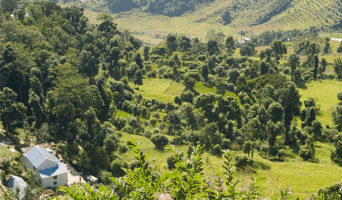
Agroforestry—combining trees and shrubs with crop and livestock production—is important for smallholder farming in Nepal. (Photo: Sajal Sthapit)
CURWOOD: It’s an encore edition of Living on Earth – I’m Steve Curwood. Agriculture is responsible for about a THIRD of the world's greenhouse gas emissions-- more than the transportation sector. About half of those emissions come directly from crop and livestock production, and much of the rest from land clearing and degradation for food production.
Sara Scherr is an economist and head of Ecoagriculture Partners. She wrote an article on agriculture and climate change in this year’s State of the World book by the Worldwatch Institute. Ms. Scherr says changing the way we farm could be one of the least painful and most effective ways of cutting emissions.
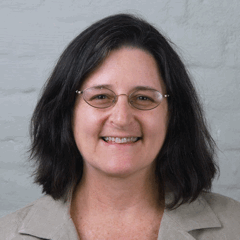
Sara Scherr
CURWOOD: So, you could either drive an electric car or quit eating meat. Is that what you're telling me?
SCHERR: Well quit eating meat or make sure that you eat meat from kind of a sustainable live stock production system.
CURWOOD: How could one make a sustainable meat production that wouldn't add to climate change?
SCHERR: Well, so much of the world's annual crop production is used to feed cattle. And a lot of that could be substituted for by returning to having animals instead graze on pasture. And if you have perennial pastures, long lived grasses, you can actually produce very high levels of meat and dairy production without having to depend upon the use of a lot of grain. Apart from what they eat, one of the big problems for livestock is actually the gases that they produce in their stomach and the manure and waste that they produce because those are very full of a particularly powerful greenhouse gas called methane. So there's a number of approaches that are being used to try to reduce those. One of them is trying to use the manure in clever ways, by actually using the manures and the other wastes from livestock as a source of biogas. So we have a lot of really – you know thousands and thousands of farms around the world heating their buildings with the waste that came out of their live stock production.
CURWOOD: How does tilling the soil increase CO2 emissions and what is no till agriculture anyway?
SCHERR: Well, if you look at all the different places that carbon is stored in the world, it turns out that the third most important sink is actually the world's soils. And the process of conventional agricultural tillage, where you take a plow or other implements and turn the soil around at the beginning of the cropping season – actually every time you do that, you release a large amount of carbon from the soils. So one of the things that's been developed in modern agricultural systems over the last couple of decades is something that's called minimum tillage or even no till systems that really try to not turn the soil around very much. They manage soil quality and they manage the weed problem through other kinds of methods that don't require turning that soil around.
CURWOOD: How does no till agriculture affect crop production? I mean, we've got more and more people coming into the world. Obviously that means more and more mouths to feed. The way that we farm, we do this –right – because we want bigger and better harvests. How can we do that with no till agriculture?
SCHERR: Well, I think this is the exciting thing about what's going on right now in terms of the reconsideration of how we do agricultural production, because actually a lot of the things that we do, that cost money and cause environmental damage actually don't contribute that much to agricultural production. So a lot of the no till systems and low till systems farmers like a great deal because they can produce just as food with them for a lot less cost. So it's a win for the environment, a win for farmers and a win for food production.
CURWOOD: Of course climate change is not only affected by agriculture. It works the other way around. I mean climate change is gonna have a big effect on agriculture. So, how do the techniques that you're talking about help farmers prepare for the warmer temperatures that are coming?
SCHERR: One of the advantages of the approaches for mitigating climate, which is to get more organic matter in your soils, is that those kinds of activities actually make the farming system much more resilient. High organic matter soils actually hold water better.

Agroforestry—combining trees and shrubs with crop and livestock production—is important for smallholder farming in Nepal. (Photo: Sajal Sthapit)
CURWOOD: So how then does the world encourage these agricultural techniques?
SCHERR: Most of us think about farmers as producing food, which of course, is the major thing we want them to do. But more and more we realize that farmers are actually the major stewards of our ecosystems around the world, by far - far more than public protected areas or other kinds of local lands. The farmers are the stewards. And we need to be thinking about them and their role, not only as producers of food, but also as producers of ecosystem services. So, I think, we need to be rethinking everything from our public subsidies and what do we subsidize farmers to do and increasingly we need to subsidize them not for producing food we don't want, but for producing the ecosystem services that we need.
CURWOOD: Sara Scherr is president and CEO of Eco Agriculture Partners, one of the organizations that contributed to this year's State of the World study by the Worldwatch Institute. Thank you so much, Sara.
SCHERR: Thank you very much. It was a pleasure to be here.
Related link:
Ecoagriculture Partners
Food Deserts
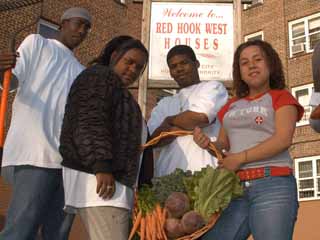
Youth farmers in New York City. (Courtesy of Added Value)
CURWOOD: Rural farmers are not the only ones with dirt under their fingernails and an abundance of zucchini this year. Some inner-city communities are also reaping the benefits of a late summer harvest, showing that they, too, can have access to fresh, organic food.
In these tough times this is especially important. Government figures show that some 36 million people live in households that have trouble just putting food on the table. Living on Earth’s Jessica Ilyse Smith tells us about efforts in New York City to bring high quality foods to struggling neighborhoods.
[SOUNDS AT A BODEGA]
SMITH: It's Saturday morning at the Cemalyn Grocery in Brooklyn. Cesar Rodriguez tends to his customers.
[SOUNDS OF RODRIGUEZ RINGING UP CUSTOMERS]
SMITH: Soda, cookies, chips and canned foods line the walls of Rodriguez's bodega. But, among the sea of processed foods and packaged goods, stands a small outpost of fresh fruits and green leafy vegetables.
[RODRIGUEZ POINTING OUT THE FRUITS AND VEGETABLES IN SPANISH]
SMITH: Rodriguez recently added these fresh foods to his store. He's one of almost 1,000 bodega owners taking part in New York City's Healthy Bodegas Initiative.
[RODRIGUEZ SPEAKING SPANISH]
VOICEOVER: Through the program, we're trying to improve people's health and the health of the neighborhood, have people eat healthier products, and lose weight because obesity is a sickness here in our community.
SMITH: Low-income neighborhoods like Rodriguez's have few supermarkets or other options for fresh fruits and vegetables. Yet there are many places to buy fast food, candy and alcohol.
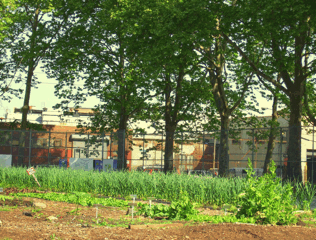
Early growing season at Red Hook Community Farm. (Photo: Jessica Ilyse Smith)
BARONBERG: These areas have many more bodegas than supermarkets and very few supermarkets in fact. That really inspired me to work to make these large environmental changes to make it easier for people to eat healthier.
SMITH: So, in 2006 Baronberg began to work with bodega owners and kicked off the Healthy Bodegas Initiative. She saw that residents wanted to change what they ate but needed help.
BARONBERG: Nobody wants to live a life of chronic disease. So people would say to me I really want to make these changes, I want to switch to 1% milk, I want to eat more fruits and vegetables, I want to be healthier but I can't. My bodega only sells junk food and there aren't any supermarkets. So what am I supposed to do? And, you know, there is nothing more frustrating than that.
SMITH: New York City's neighborhoods are not the only areas with limited access to healthy food. These so-called food deserts are found across the country in rural and urban locations. Mark Winne has looked at food deserts for years.
WINNE: It's relative based on how far somebody has to go in order to get to any kind of decent, affordable food store, and the means that they have to get there. And do they in fact have the means?
SMITH: Winne is the author of "Closing the Food Gap: Resetting the Table in the Land of Plenty." In the book, he chronicles the rise of food deserts in the 1960's, alongside the growth of the American suburb. With scores of people leaving downtown areas, inner cities were drained of wealth. Supermarket chains followed the wealthier client base and moved to the suburbs.
WINNE: They simply began to walk away from urban America. And these were communities that needed those stores more than others. They were communities that were being challenged by poverty, being challenged by some of the worst socioeconomic conditions that we've had perhaps in the 20th century.
SMITH: It wasn't just the lack of supermarkets that led to the growth of food deserts, but also the lack of public transportation to bring urban residents to suburban grocery stores. Winne says nearly 70% of households in low-income neighborhoods do not own a car.
As an example he highlights the 8th ward of Washington D.C., which is close to the U.S. Capitol building. In this area, nearly 70,000 residents live with slim access to grocery stores.
WINNE: About 38% of those people are considered poor using U.S. poverty standards. If you look at the landscape we see almost no supermarkets and we also see another characteristic of a food desert, which is a tremendous number of fast food joints. And that's what people have to choose from for food. And as a result we see very high levels of obesity.
SMITH: Costs from obesity and related chronic diseases are increasing. According to the Centers for Disease Control and Prevention, the U.S. spends over 117 billion dollars a year on healthcare related to obesity. And in low-income neighborhoods with lots of fast food and few healthy options, the obesity rate is rising.
[SOUND OF RAKING LEAVES]
SMITH: Over in the Red Hook neighborhood of Brooklyn, Eugene rakes leaves that he'll add to one of the compost piles lining the side of an urban farm.
EUGENE: We have our compost beds over here that we've been processing for a long time. We have one that was built two months ago, and it's almost done but it's not all the way done. It's almost broken itself down, all of the nutrients and stuff like almost broken down and created our soil that we use.
SMITH: Eugene is one of about ten neighborhood teens who work at the Red Hook Community Farm. The farm - run by the non-profit group Added Value - was literally built from the ground up. Soil was brought in to cover an old abandoned ball field. If you look closely on the outskirts of the rows of onions, lettuce and beets you can still see home plate and the faint white lines that mark the field's boundaries. This farm has not only increased the community's access to fresh and affordable fruits and vegetables, but also has helped change the neighborhood.
EUGENE: Before the farm I'd say it was pretty much a little badder, because there was still a lot of gang violence and stuff like that going around here. I'm just basically proud of being here and helping out and being able to bring healthy food to my neighborhood that I live in.
SMITH: Eugene and other teens plant seeds, harvest crops and sell their bounty at a farmer's market in the neighborhood. Before the farm started, residents went through a lot to get fresh food.
KATE: I took two buses or a car service to get food back to Red Hook. I mean you couldn't even get a quart of milk, or vegetables.
SMITH: Kate and many other Red Hook residents who buy their produce from the farm understand that fresh fruit and vegetables are important for their health. William Lewis is a longtime resident who didn't like what he found in the neighborhood before the farm.

(Courtesy of Added Value)
SMITH: The farmer's market has become a neighborhood gathering place, and teens at the farm not only earn money and learn how to grow food, they also learn how to be stewards of their community, a community that is focusing on changing the circumstances of its health. Efforts like this inspire author Mark Winne:
WINNE: So it's the human innovation, creativity, willingness as a community in some sort of organized social way, and political way of trying to change the circumstances that they live in—and that really inspires me.
SMITH: Programs like the Added Value farm and the Healthy Bodegas Initiative operate from the ground up to improve the health of people living in food deserts. They also help to close what Winne calls the food gap that severely divides Americans.
For Living on Earth, I'm Jessica Ilyse Smith in New York City.
[MUSIC: Daniel Lanois “O Marie” from Acadie (daniellanois.com)]
Related links:
- Added Value
- Healthy Bodegas Initiative
- “Closing the Food Gap” by Mark Winne
The Language of Landscape
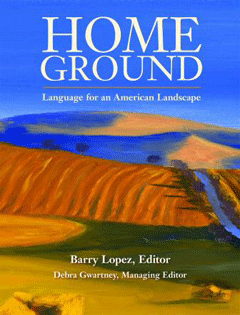
Home Ground: Language for an American Landscape, edited by Barry Lopez and Debra Gwartney/ (Courtesy of Trinity University Press)
CURWOOD: Our land – our Home Ground is soil. And soil – that humble, vital basis of all the greenery we depend on - is the subject of this excerpt from the book “Home Ground, Language for an American Landscape”.
Nature writer Barry Lopez and fellow author Debra Gwartney gathered lyrical descriptions of landscape features in this book. Today Barry Lopez explains – soil.
LOPEZ: Soil. Erosion, volcanic eruption, earthquakes, floods, tectonic grinding, landslides, and other natural forces act continuously on the earth's crustal rock, creating various types of debris—gravel deposits, mudflats and the tidal estuaries of creeks, cobble terraces, and beaches of black lava sand. When chemical agents, such as phosphorus and nitrogen, infuse this debris, and biological entities including microbes and earthworms work material into it organic enough to support plants, it becomes soil. A soil that is chemically or organically exhausted, that's been pulverized or become deeply parched, that has been invaded by decomposing rock, or that's been fowled by sewage or industrial pollution to the point where it no longer can support plant life, is called dirt.
[MUSIC: Tom Verlaine “Spiritual from Warm And Cool (Thrill records 2006)]
CURWOOD: That's writer Barry Lopez, who together with Debra Gwartney, created "Home Ground: Language for an American Landscape."
Related link:
Home Ground: Language for an American Landscape
Seedy Art

Dolly Parton, made from seeds and cornhusks. (Moncrief Speaks)
CURWOOD: In this season of harvest all of that bounty is on display at state fairs across the country – from jams and pies to enormous squash and pumpkins and prize-winning tomatoes. Living on Earth’s Bobby Bascomb attended the Minnesota harvest celebration in St. Paul last year and encountered an unusual art display. She has this audio postcard.
[MUSIC: David Grissman & Jerry Garcia “Grateful Dog from The Grateful Dawg Soundtrack (Acoustic Disc 2001)]
RUSSELL: My name is Beth Russell. I am from Western Minnesota. All of the artwork that you see on the wall is done with seeds from Minnesota farm crops. It has to be grown here. Therefore, white rice doesn't work.
[MUSIC: Jerry Garcia & David Grissman "Grateful Dawg" from The Grateful Dawg Soundtrack (Acoustic Disc 2001)]
RUSSELL: So we use wheat and barley, and oats, corn, different varieties of corn, we might have some that looks more yellow, some that's more red. Some of our lentils are green, some are orange. So there's all kinds of colors in the scene. We have beans – kidney beans, lima beans, soy beans.
[MUSIC: Jerry Garcia & David Grissman "Grateful Dawg" from The Grateful Dawg Soundtrack (Acoustic Disc 2001)]
RUSSELL: The "founding mother" of crop art from Minnesota – I'm giving her that title – she's called the Seed Queen. She has done Johnny Carson, Eleanor Roosevelt, and if you look at Eleanor Roosevelt in the seed art that Lillian Colton did, Eleanor's teeth are beans, they're great northern beans, which is just phenomenal to me.
[MUSIC: Jerry Garcia & David Grissman "Grateful Dawg" from The Grateful Dawg Soundtrack (Acoustic Disc 2001)]
RUSSELL: A typical seed art piece will have somewhere between eight to ten to twelve different kinds of seeds. We ask each one of our artists to come in with what we call a seed chart that tells us the name of the seed and shows us what it is. It's a very important part of the display.
[MUSIC: Jerry Garcia & David Grissman "Grateful Dawg" from The Grateful Dawg Soundtrack (Acoustic Disc 2001)]
RUSSELL: One of our categories is wearable art. So I have corn on a chain, dangling from my ears. It's a little zany, a bit of funkiness. A young man last year called me corn ears – it was very appropriate. It's rather distinctive, actually, I get a lot of comments on it. I think it's croppy. I think it looks croppy ... [LAUGHING] ... to go with farm crops.
[MUSIC: Jerry Garcia & David Grissman "Grateful Dawg" from The Grateful Dawg Soundtrack (Acoustic Disc 2001)]
CURWOOD: Living on Earth's Bobby Bascomb sent us that audio postcard from last year’s Minnesota State Fair. This year’s event is right around the corner, running from August 27 through Labor Day.
[MUSIC: Jerry Garcia & David Grissman "Grateful Dawg" from The Grateful Dawg Soundtrack (Acoustic Disc 2001)]
CURWOOD: Just ahead – searching for the quiet places of nature in our noisy world. Stay with us on Living on Earth.
Related link:
Click here for more on seed art.
In Search of Silence
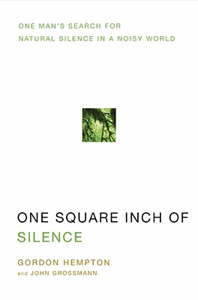
CURWOOD: You’re listening to an encore edition of Living on Earth. I’m Steve Curwood. Gordon Hempton has dedicated his life to listening. As an acoustic ecologist, Mr. Hempton has captured audio landscapes on every continent except Antarctica, criss-crossing some of the most unbeaten paths on the globe with his recording equipment.
He joined me from Seattle to talk about his book – the result of his 10,000 mile trans-American quest. The title is “One Square Inch of Silence; One man’s search for Natural Silence in a Noisy World.” I asked him to describe this place, this one square inch of silence.
HEMPTON: Olympic National Park is truly the listener's Yosemite. It's often called three parks in one because there are three areas that in another park would justify its entire existence. We have glacier-capped mountains, we have the temperate rain forest and we have a wilderness seashore. Now this is a world heritage site and also a biosphere reserve.
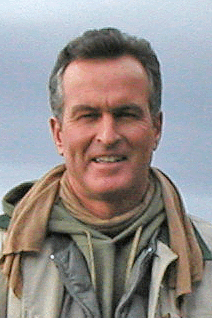
Author Gordon Hempton
CURWOOD: Tell me exactly where is this one square inch of silence.
HEMPTON: One square inch of silence is three point two miles up the Hoh River Trail, a trail that's lined with the world's tallest living creatures, moss covered, dug fir, western hemlock, western red cedar, sitka spruce. On a moss-covered log, I placed a stone given to me by the Quileute elder, David Fourlines.
And at this stone, I promised to defend from all noise intrusions. And by defending this simple one square inch of silence, I'm able to manage the thousand square miles around it, which is roughly the size of Olympic National Park. And the way that that works, for a moment, because people say to themselves "well, how does that work?"
Well just like noise can impact quiet, quiet can also impact noise. So imagine a jet overhead – and this is very much true – that a jet overhead, even at 38,000 feet cruising altitude is literally destroying 1,000 square miles of oral solitude below it. Well if you can maintain a single point absolutely 100 percent free of all human-caused noise intrusions, then in effect what that does is manage the noise impacts for a thousand square miles around it.
CURWOOD: We have some of your sound from this place. Let's play it right now.
[BIRDS SOUNDS, BUZZING, CROAKING]
CURWOOD: Well, actually, this is a pretty busy place, Gordon.
HEMPTON: Oh it can be. That's definitely a springtime recording. It's busy, lot of wildlife. We're hearing a varied thrush there, a pacific chorus frog. They're as busy communicating as we are. They have more important things to say, I think, than we have to say when we're in a wilderness area.
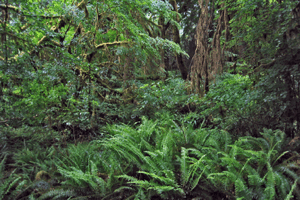
The Hoh Rainforest, home to one square inch of silence. (Courtesy of Gordon Hempton)
CURWOOD: Why do ecosystems need to be free of human noise?
HEMPTON: Steve, I think the whole earth is speaking. I hear it speaking. And so to ask me which ecosystem deserves to be heard, I think they all deserve to be heard. They all have something to say. Imagine this: all higher vertebrate species have the ability to hear, although not all species have the ability to see – hearing is vital for survival. And we don't have ear lids, do we? In fact, no creature has ear lids, although we seem to have plenty of eyelids. It's not only important that we hear, but it's important that we listen. And I don't think that we're an exception to the animal kingdom.
So, if I would say what are my big, you know, hit list or first go, first see, first listen to the ecosystems, well, I would just jump right into the Amazon, because the earth is a solar powered jukebox. The more sun that hits the surface of the earth, basically, the louder it is. The Amazon, you know, that natural silence per se is really ripping, it's a conversational voice. It is so ever-changing that you can identify the correct time of day just off the sound alone within five minutes.
And then jump up to Central America. I like Belize particularly.
And jump up further, it's the songbirds of the southeast in Georgia. Of course, we're in a economically developed country now, the United States, and with all that fossil fuel consumption, the solar powered jukebox is getting a little refigured because of all the transportation of this solar power.
And then jump up to the Canadian border here in eastern Washington, also western Washington, and there's a poetics of space that is just really remarkable, because, when you make a quiet recording, like the recording of coyotes singing, is this a recording of coyotes, or is this a recording of silence made audible by coyotes?
[COYOTES HOWLING]
HEMPTON: Listen closely, Steve, because there's not one coyote, but there're two. And they're singing to each other after a long season of prosperity and to me it sounds like a celebration. But the point that I think that they really bring out is that if there were the slightest jet rumbling in the background, the experience of these coyotes would be entirely different.
[COYOTES HOWLING]
HEMPTON: Another recording, that I think will just really floor you, just like it floored me. I heard this – I read in John Muir's journals – he describes snow melting into music. So, when you hear somebody say that or you read it yourself, you go "Oh, well what a poetic license. Isn't that great." But little might we guess, unless we actually do listen.
[SOUNDS OF SNOW MELTING, MARMOT CALL]
HEMPTON: That's the Olympic marmot by the way, that's an endangered species. It's an endemic, just there at Olympic National Park.
[MARMOT CALL, SOUND OF SNOW MELTING]
HEMPTON: At this point you don't know how hard it was for me not to just like stand up, wreck that recording because I just had to dance. I mean, yes, John Muir, thank you.
CURWOOD: Well I didn't know Ma Nature was a jazz musician.
HEMPTON: Oh yeah, sure is. Are you a player yourself?
CURWOOD: [laughing] Nothing you'd want to have on the air
[LAUGHING]
HEMPTON: Okay.
CURWOOD: And, of course, people know John Muir as the naturalist who was the founder of the Sierra Club and inspired much of what we have in the way of national parks. And I gather you actually went to the place in Montgomery, Tennessee where Muir had his own epiphany about the environment. So tell me, Gordon, why was this one creek in Tennessee so important for you to visit and what was it that you found there?
HEMPTON: Sure, well the creek of Montgomery Creek in Tennessee was, you know, a shrine that I would like to go to. In fact, I'd thought about it for fifteen years and never had the opportunity, because it's the first place that Muir describes the sound of a mountain stream and calls it the most eloquent voice in nature. And he goes on, of course, to Yosemite, years later, and that is the most frequent sound that he describes in all of his journals is the sounds of water, mountain streams. And so this is the very first chance that I have to visit that location and think about Muir.
CURWOOD: So when you get there, who's there? Who do you meet?
HEMPTON: Well I find the creek, and I meet Randy. Randy is operating this large water truck for the National Coal Plant. And he sucks up water – he says that there's no water, no coal – he says. And so he's sucking up like a thirsty elephant, and then he drives off. But not until he gives me a suggestion on where I might find quiet.
CURWOOD: If you could read from that, it would be wonderful.
HEMPTON: "At Randy's suggestion, I'm walking Roach's Creek up the valley imagining I'm in Muir's footsteps. Walking in the stream itself, I'm able to hear its changing voice. No two rocks are the same, no two flows are the same. At every step, a new combination, new notes. In a different time, Muir's time for instance, I could have lost myself in these subtle variations, but with the distant din of National Coal Corporation mine number eleven in the background, it's impossible to bend a calm ear. 'Nothing more eloquent in nature than a mountain stream,' Muir wrote in his journal very near to where I'm standing. What would he write today?"
CURWOOD: Gordon, we live in noisy culture, what's to be done?
HEMPTON: Well our culture is noisy. What we can do today, number one, is include quiet in your life, simply include quiet in your life. Silence cannot be imagined, although a lot of people think so. Most people that are listening to this are recalling a quiet place that they have been in the last year. Well, I have to say, listen again.
CURWOOD: Tell us about an encounter or moment that just gave you hope for the future of the sound of nature in America, quiet in America.
HEMPTON: Every opportunity to hear nature undisturbed by motor noise inspires me, gives me hope. There are two places where that did happen on a ten thousand mile trip. And one in particular was Canyonlands, Canyonlands National Park, and many people may know this either personally or from the writings of Edward Abbey.
And it's there at night where you can look at the countless stars and simply be and breathe with the sighing of the wind – such a deep and peaceful sleep – and to be able to gaze out at – instead of trees that are hundreds of years old – you're gazing out at a moonlit landscape where the rocks are millions of years old. This is a witness to being a miracle. How can we not gain inspiration? So, when I think about how are we going to quiet our culture, well for one thing, I don't think there's any choice. And the immense benefits from this – health for ourselves and also for wildlife – I believe we will. I believe we'll quiet it. Beginning with Olympic National Park.
CURWOOD: Gordon Hempton's book is “One Square Inch of Silence." Thank you so much, Gordon,
HEMPTON: Thank you, Steve.
[MUSIC: Groove Galaxi “Silence” from Back On Deck (Traumton 2004)]
Related link:
The One Square Inch of Silence website
The Art of Mud

An imperfect mudball. (Photo: Bethany Ericson)
CURWOOD: Playing in the mud can be great summertime fun…but for commentator Bethany Ericson …her brother went too far.
ERICSON: Last summer, my brother had a thing for mud. What's unusual about this is that my brother is a 41-year-old academic.
One minute he was reading random articles online, and the next he was transfixed with the dirt in his yard.
He'd read that Japanese schoolchildren were going through a craze of making perfect mud balls in playgrounds.
These mud balls, called hikaru dorodango, aren't just balls of wet soil. They're perfectly smooth, dry balls encased in a glossy shell. Supposedly patiently layering mud, then burnishing it with fine dirt can achieve this, and my brother was determined to find out.
Neither of us had ever made a ball of dirt look like a polished marble when we were kids. Nor had anyone we knew heard of a dorodango. My brother lives in a tiny, forested town with dial-up internet service, but he was intrigued enough to sit for ten minutes stabbing at pop up ads just to carefully watch a video of someone stroking a handful of mud.
The obsession took hold. He no longer talked about the books he had just read, or even the other art he'd created. Instead he’d enlighten us about the best patches of dirt in a two-mile radius. The old plastic post office mail bin in his living room that had once held poetry manuscripts was now full of what he called the "good dirt." His worn tan Carhardts took on a gray tinge, and his hands mechanically formed everything he picked up into a sphere.
My brother refused to be out-balled by Japanese toddlers. Each stage of his day became carefully metered out into the minutes of layering, the half hour of moisture controlled curing in the fridge, the hour of dusting with fine clay. He stayed up late, patting and rounding.
The more involved he got, the more he failed.
He invited everyone to join him. We all made excuses. We found ways to bring up people we knew who were obsessive compulsive, and then we'd stare at him pointedly as he cradled a mug of coffee in one dirt-lined hand and a mud ball in the other.
Each of his days ended with a glimpse of pride and hope: several shiny dorodango nestled together on a Frisbee. Every morning they were shattered.
Finally in the fall, my brother literally washed his hands of the whole affair. Perhaps his lesson was in resolve, or perhaps just rumination. Maybe he could have opened up a meditation retreat, where people would pay to walk around slowly all day, massaging a mud orb. But instead he got emotionally involved, and in the end the mud balls were good for one thing: throwing.
Anyway, my brother is moving forward. Now he's into rocks.
[MUSIC: Dr. John “Mississippi Mud” from Dr. John Plays Mac Rebennack: The Legendary Sessions Vol. 2 (Clean Cut Music 2006)]
CURWOOD: Bethany Ericson is a writer and artist from Cambridge, MA.
CURWOOD: On the next Living on Earth:
The ancient cliff dwellings at Bandelier National Monument in New Mexico are being vandalized.
HUME: To me, it's like coming into my house and carving your name on my wall. You know, that's how I feel that these are disrespectful. I wouldn't go into anybody's house and carve my name into their wall.
CURWOOD: Restoring sacred sites – next time on Living on Earth.
[DESERT SOUNDS]
CURWOOD: We leave you this week in “Desert Solitude.”
[DESERT SOUNDS]
CURWOOD: Not a plane flies overhead nor a car drives by this section of Gray Ranch, a 500 square mile Nature Conservancy easement in the panhandle of New Mexico.
Bernie Krause found his patch of silence at dawn. He recorded coyotes, desert birds, and dry winds for his series wildsanctuary.com.
[DESERT SOUNDS: Bernie Krause "Desert Solitudes from Desert Solitudes (Wild Sanctuary 2002)]
CURWOOD: Living on Earth is produced by the World Media Foundation. Our crew includes Bobby Bascomb, Eileen Bolinsky, Bruce Gellerman, Ingrid Lobet, Helen Palmer, Jessica Ilyse Smith, Ike Sriskandarajah, Mitra Taj, and Jeff Young, with help from Sarah Calkins, Marilyn Govoni, Sammy Souza and engineering assistance from Dana Chisholm. Our interns are Annie Glausser and Lisa Song. Jeff Turton is our technical director. Dean composed our themes. You can find us anytime at LOE dot org. I’m Steve Curwood. Thanks for listening.
Living on Earth wants to hear from you!
Living on Earth
62 Calef Highway, Suite 212
Lee, NH 03861
Telephone: 617-287-4121
E-mail: comments@loe.org
Newsletter [Click here]
Donate to Living on Earth!
Living on Earth is an independent media program and relies entirely on contributions from listeners and institutions supporting public service. Please donate now to preserve an independent environmental voice.
NewsletterLiving on Earth offers a weekly delivery of the show's rundown to your mailbox. Sign up for our newsletter today!
 Sailors For The Sea: Be the change you want to sea.
Sailors For The Sea: Be the change you want to sea.
 The Grantham Foundation for the Protection of the Environment: Committed to protecting and improving the health of the global environment.
The Grantham Foundation for the Protection of the Environment: Committed to protecting and improving the health of the global environment.
 Contribute to Living on Earth and receive, as our gift to you, an archival print of one of Mark Seth Lender's extraordinary wildlife photographs. Follow the link to see Mark's current collection of photographs.
Contribute to Living on Earth and receive, as our gift to you, an archival print of one of Mark Seth Lender's extraordinary wildlife photographs. Follow the link to see Mark's current collection of photographs.
 Buy a signed copy of Mark Seth Lender's book Smeagull the Seagull & support Living on Earth
Buy a signed copy of Mark Seth Lender's book Smeagull the Seagull & support Living on Earth

